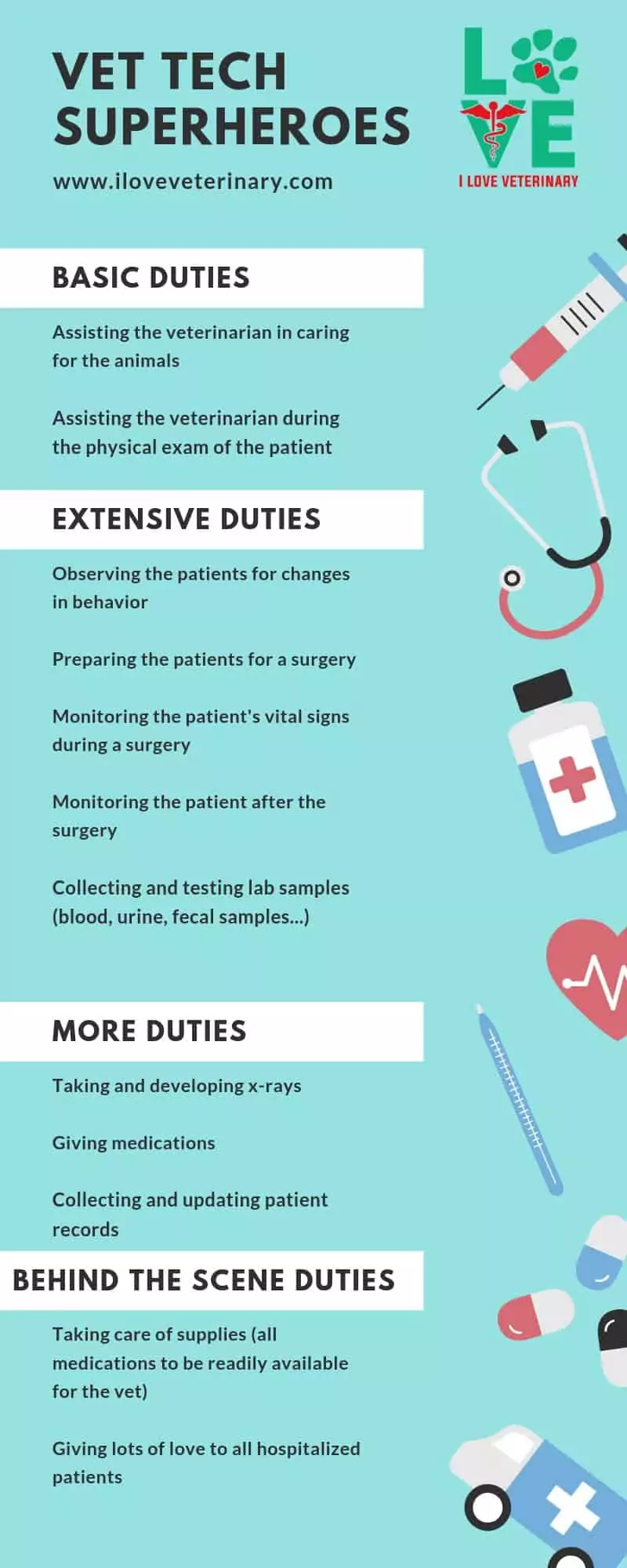Enjoy our Vet Tech Responsibilities and superheroes infographic about all the duties they have.
What is a Veterinary Technician?
A veterinary technician is a certified professional in the field of veterinary technology who provides technical support for veterinarians in the process of patient care. Besides veterinarians, a vet tech is equally involved in the care of patients in veterinary hospitals and represents a valuable team member and irreplaceable asset.
The veterinary technician is the person that greets new patients in the waiting room. He/she then escorts the client and the pet to the examination room. If the veterinarian performs the physical exams the vet tech listens and takes notes, as well as taking notice of the reasons for the visit.
The vet tech can also perform a physical exam and pass the information to the veterinarian afterward.
How to Become a Veterinary Technician
The most secure way of becoming a vet tech in the United States is by completing a veterinary technician or veterinary technology program which is accredited by the AVMA (American Veterinary Medical Association).
These programs last for two years and there are around 160 of them across the US at universities, colleges, and community colleges. After completing it the students get awarded with an Associate’s Degree of Applied Science in Veterinary Technology. You can also attend vet tech schools online.
When a potential vet tech finishes an accredited program he/she then needs to take the VTNE (Veterinary Technician National Examination). With a positive score on the exam, you get the proper vet tech certification in order to work in the field.
Students that passed the VTNE are waived from taking a state-issued exam and become a certified veterinary technician, registered veterinary technician, or licensed veterinary technician.
Get this as a poster for your clinic or classroom! Order HERE!

Read more about all the duties and responsibilities of the veterinary technicians and all the ways to become one “Everything you need to know about becoming a vet tech” on our blog.
Vet Tech Responsibilities
A vet tech’s duties vary depending on what kind of practice they work in. A vet tech that works primarily with cats, for example, will have different job responsibilities than a vet tech that works primarily with dogs.
- In a cat-only practice, the primary role of a veterinary technician may include: Conducting physical exams and basic lab tests
- Preparing vaccines and medications to be given to the animals. This includes measuring out doses based on weight and preparing bottles of vaccine or medication for an injectable drug.
- Maintaining patient records in the form of charts, appointment books, and lab work including entering data into computers. They may also be responsible for keeping this information organized and up to date when needed.
- Feeding animals in an animal hospital setting when no one is available to do so. This includes preparing food trays, placing them out on a counter near each enclosure, and removing any uneaten food at the end of the day.
- In a small animal practice that does not perform surgery, a veterinary technician’s job responsibilities may include:
- Taking radiographs (x-rays) of pets using digital x-ray equipment.
- Recording what they see through imaging software on computer screens, either by hand or by using a stylus. They may also be responsible for writing down what the radiologist says.
This is not an exhaustive list of what a vet tech can expect to do in their job, but should give you an idea of what might be expected. Vet techs that work in clinics that perform surgery and assist with procedures or during emergency situations will have different roles than those outlined above.
